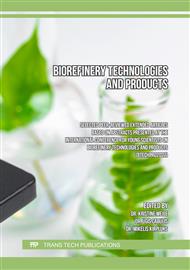[1]
J. Patočka, Biologically Active Pentacyclic Triterpenes and Their Current Medicine Signification, J. Appl. Biomed. 10 (3) (2012) 7–12.
DOI: 10.32725/jab.2003.002
Google Scholar
[2]
D. N. Vedernikov, N. Y. Shabanova, V. I. Roshchin, Change in the Chemical Composition of the Crust and Inner Bark of the Betula Pendula Roth. Birch with tree height, Russ. J. Bioorganic Chem. 37 (7) (2011) 877–882.
DOI: 10.1134/s1068162011070259
Google Scholar
[3]
J. Rizhikovs, J. Zandersons, G. Dobele, A. Paze, Isolation of Triterpene-Rich Extracts From Outer Birch Bark by Hot Water and Alkaline Pre-Treatment or the Appropriate Choice of Solvents, Ind. Crops Prod. 76 (2015) 209–214.
DOI: 10.1016/j.indcrop.2015.06.053
Google Scholar
[4]
S. Amiri, S. Ahmadi, M. Mehrbod, P. Khadem, F. Behrouj, H. Aghanoori, M. R. Machaj, F. Ghamsari, M. Rosik, J. Hudecki, A. Afkhami, A. Hashemi, M. Los, M. J. Mokarram, P. Madrakian, T. G.Saeid., Betulin and Its Derivatives as Novel Compounds With Different Pharmacological Effects, Biotechnol. Adv. 38 (2020) 1–39.
DOI: 10.1016/j.biotechadv.2019.06.008
Google Scholar
[5]
S. Alakurtti, T. Mäkelä, S. Koskimies, J. Yli-Kauhaluoma, Pharmacological Properties of the Ubiquitous Natural Product Betulin, Eur. J. Pharm. Sci. 29 (2006) 1–13, (2006).
DOI: 10.1016/j.ejps.2006.04.006
Google Scholar
[6]
A. Z. Abyshev, É. M. Agaev, A. B. Guseinov, Studies of the Chemical Composition of Birch Bark Extracts (Cortex betula) From the Betulaceae family, Pharm. Chem. J. 41 (8) (2007) 419–423.
DOI: 10.1007/s11094-007-0091-5
Google Scholar
[7]
D. Blondeau, A. St-Pierre, N. Bourdeau, J. Bley, A. Lajeunesse, I. Desgagné-Penix, Antimicrobial Activity and Chemical Composition of White Birch (Betula papyrifera Marshall) Bark Extracts, Microbiologyopen. 9 (1) (2020) 1–23.
DOI: 10.1002/mbo3.944
Google Scholar
[8]
R. Berzins A. Paze, J. Rizhikovs, R. Makars, D. Godina, M. Lauberts, K. Stankus, Influence of Solvents on the Antioxidant Properties of the Birch Outer Bark Extract in Cosmetic Emulsions. Key Eng. Mater., 903 (1) (2021) 28–33.
DOI: 10.4028/www.scientific.net/kem.903.28
Google Scholar
[9]
R. Makars A. Paze, J. Rizikovs, R. Berzins, D. Godina, M. Puke, K. Stankus, I. Virsis, Changes in Composition of Birch Outer Bark Extractives After Recrystallization with C2-C5 Alkanols, Key Eng. Mater. 850 (1) (2020) 3–8.
DOI: 10.4028/www.scientific.net/kem.850.3
Google Scholar
[10]
N. A. J. C. Furtado, E. Laetitia, H. Miranda, L. M. Loira-Pastoriza, C. Preat, V. Larondelle, Y. André, Pentacyclic Triterpene Bioavailability: An Overview of in vitro and in vivo Studies, Molecules, 22 (3) (2017) 1–24.
DOI: 10.3390/molecules22030400
Google Scholar
[11]
R. Al-Kassas, M. Bansal, J. Shaw, Nanosizing Techniques for Improving Bioavailability of Drugs, J. Control. Release. 260 (17) (2017) 202–212.
DOI: 10.1016/j.jconrel.2017.06.003
Google Scholar
[12]
X. Zhao, W. Wang, Y. Zu, Y. Zhang, Y. Li, W. Sun, C. Shan, Y. Ge, Preparation and Characterization of Betulin Nanoparticles for Oral Hypoglycemic Drug by Antisolvent Precipitation, Drug Deliv. 21 (6) (2014) 467–479.
DOI: 10.3109/10717544.2014.881438
Google Scholar
[13]
R. Bardestani, G. S. Patience, S. Kaliaguine, Experimental Methods in Chemical Engineering: Specific Surface Area and Pore Size Distribution Measurements BET, BJH, and DFT, Can. J. Chem. Eng. 97 (11) (2019) 2781–2791.
DOI: 10.1002/cjce.23632
Google Scholar
[14]
J. J. Kipling R. B. Wilson, Adsorption of Methylene Blue in the Determination of Surface Areas, J. Appl. Chem. 10 (3) (2007) 109–113.
DOI: 10.1002/jctb.5010100303
Google Scholar
[15]
T. Skripkina, E. Podgorbunskikh, A. Bychkov, O. Lomovsky, Sorption of Methylene Blue for Studying the Specific Surface Properties of Biomass Carbohydrates, Coatings, 10 (11) (2020) 1–10.
DOI: 10.3390/coatings10111115
Google Scholar
[16]
G. I. Malicev, A. A. Zaharova, Study of Betulin Stability by Electrokinetic Potential determination, UGLTU. 3 (78) (2021) 63–67. (in Russian).
Google Scholar
[17]
A. Itodo, H. Itodo, M. Gafar, Estimation of Specific Surface Area using Langmuir Isotherm Method, J. Appl. Sci. Environ. Manag. 14 (4) (2011) 1-5.
DOI: 10.4314/jasem.v14i4.63287
Google Scholar
[18]
G. G. Nakhwa, Specific Surface Areas of Finely Divided Solids By, J. Appl. Chem. 99 (32) (1962) 266–273.
Google Scholar



